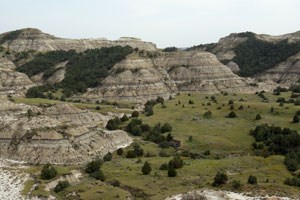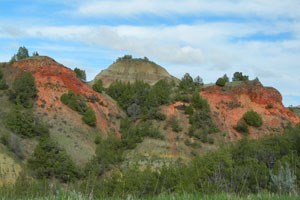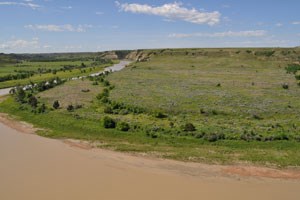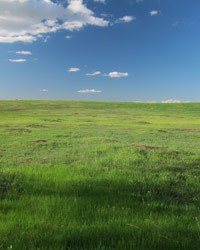
NPS photo by Joe Bruce Buttes and Clinker One of the most common landforms in the Badlands is the butte (it rhymes with "cute"). A butte is like a small hill. It has steep sides and a flat top. The side which faces south is steeper. The north side gets less sun, so it holds more moisture and can support trees called juniper. All of the extra plants prevent erosion. Their roots hold the dirt together. This creates a very different look on the two sides of the butte! The north side is covered with plants and trees, while the south side is rocky without much plant life. Buttes form by erosion. Forces like wind and water move materials around. Sometimes you can barely see it, like a piece of sand breaking off a rock. Other times it happens fast, like a mudslide! Many buttes have a hard layer of rock near the top. This layer protects the layers underneath. It is made of sandstone, limestone, or clinker. 
NPS photo Wait, what is clinker?!? Clinker is a cool type of rock found in the Badlands. It is usually red or orange, but can also be black, purple or yellow! Clinker is created from fire. Layers of lignite, a coal formed of ancient trees, are buried in parts of the Badlands. This coal can catch fire from lightning or wildfires. It burns so hot it transforms the rock near it to clinker! Like sandstone, clinker is harder than the clay and dirt in the rest of the butte. In fact, a lot of clinker used to be sandstone. That makes clinker a metamorphic (met-a-morf-ick) rock! It has been morphed, or changed, from another rock. This harder metamorphic rock tops many buttes in the Badlands. 
NPS photo by Joe Bruce Floodplains and Plateaus The Little Missouri River still flows through Theodore Roosevelt National Park. It winds back and forth like a snake. This is called meandering (me-an-der-ing). In between the bends, or meanders, of the river are broad flat places. The flat areas are floodplains. When the river floods, the water spills into these plains. These flood waters leave soil rich in nutrients. When the flood ends, plants grow again and life returns. These floods do not happen often, and many years pass before the water rises again. Not all flat places in the park are floodplains. After you cross a floodplain, the land may rise. You might be crawling up a butte; or you might see another broad plain in front of you at the top. If you are on a flat plain, then you have reached a plateau. These plateaus are windy, so the plants that grow on them are not that tall. They also have deep roots to anchor into the soil. If you are on a floodplain or a plateau, you will be surrounded by plants like this. You are in a prairie! 
NPS photo by Jeff Zylland Prairies The Badlands are filled with crazy shapes and colors! Pillars, hoodoos, clinker, burning coal! But most of Theodore Roosevelt National Park is a prairie. This is a mostly flat place with many grasses and few trees. This grassland ecosystem provides habitat for thousands of living things! A habitat is a place that offers food, water, shelter and space for living things. Even plants need a habitat. Many plants living on the prairie are grasses or shrubs. Few trees grow on a prairie. These plants are the base of our food chain in the park. They help create the prairie habitat. Keep reading to learn about the common plants found in Theodore Roosevelt National Park! You can also return to the main Learn About the Park page. Go to the vocabulary page to review the blue words you learned here. |
Last updated: August 19, 2015
